Outlier Void and Pendulum Pedals
Blister’s Measured Weights:
- Void: 230 & 230 g
- Pendulum:
- Early iteration: 206 & 207 g
- Revised version: 228 & 228 G
MSRP (both): $299 CAD ($208 USD at the time of publication)
Bolted To: Geometron G1, Contra MC, Santa Cruz Bronson, BTR Ranger, We Are One Arrival, Ibis Oso 1.1, Kavenz VHP 16, Revel ReRun
Reviewers:
- David Golay: 6′, 160 lb / 183 cm, 72.6 kg
- Zack Henderson: 6’, 160 lb / 183 cm, 72.6 kg
Test Location: Washington
Test Duration: 6 months

Intro
Outlier is a new, Calgary-based brand offering two different flat pedal designs that are, well, outliers from the rest of the market. Both the Void and Pendulum use machined aluminum bodies with stainless steel spindles and nine traction pins per side. So far, so normal, but it’s more about what they don’t have — anything in the middle of the pedal.
Outlier doesn’t stop there, though — the Pendulum pedal takes the wild design to a whole new level by using a single-sided platform that’s offset well below the centerline of the spindle to make what is, from the standpoint of the distance from the center of the spindle to the top of the platform, a negative thickness pedal. Let’s dig into the details.
Design
A lot of design elements are shared between the Void and Pendulum, with the Void’s more conventional dual-sided layout being the main thing that separates it from the single-sided Pendulum. So we’ll start with the stuff that’s common to both pedals.
Both versions use a uniquely short stainless steel spindle that doesn’t extend beyond the inner side of the pedal body, leaving a large…void in the middle of the pedal. Two cartridge bearings are housed inside the sizable bulge in the inner side of the pedal body, and each side’s traction pins thread in from the opposite face of the pedal. The distance from the mounting face on the spindle to the usable part of the platform (i.e., outside of the bearing bulge) is about 24 mm on both models.
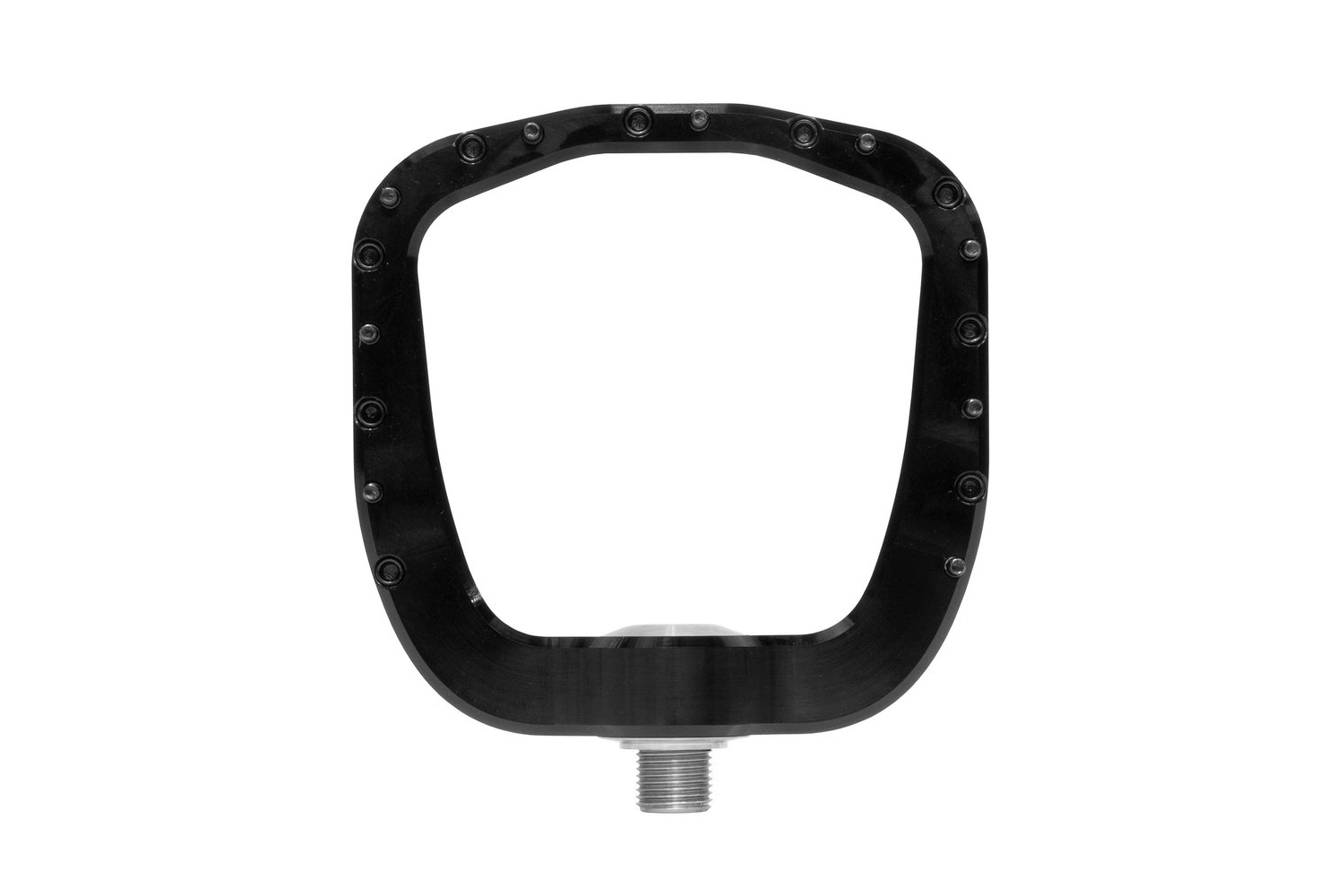
The idea behind the unorthodox platform layout is to make pedals that are very thin but still feel concave, by allowing the shoe to flex down into the opening in the center of the pedal a bit. We’ll get into the details for both pedal variants below, but they are very notably thin, especially for pedals that aren’t totally flat or even somewhat convex like other very thin pedals often are. Thin pedals help a little with pedal clearance but also make for a more stable feeling platform to stand on, with less tendency to tip fore-aft with slight shifts in weight. That second effect is far more noticeable on the trail, in my opinion. I’ve talked about my preference for thin pedals and the sense of stability that they afford a number of times, and it’s a big reason why I’ve personally settled on the HT X3 pedals as being my long-preferred clip pedal option. (OneUp’s new Clip Pedals are about the same thickness as the X3s, and my early impressions of them are also quite positive.)
Anyway, there have been a variety of attempts at making extra thin flat pedals over the years (the OneUp Aluminum Pedal and the Canfield Crampon being the most common recent examples), but they’ve generally gotten there in part by being very flat, or even slightly convex, in their platform profiles. That works great for some folks, but others distinctly prefer a concave pedal that one’s foot can settle into a bit — myself included. Outlier is trying to pull off pedals that are exceptionally low profile while still affording some concavity.
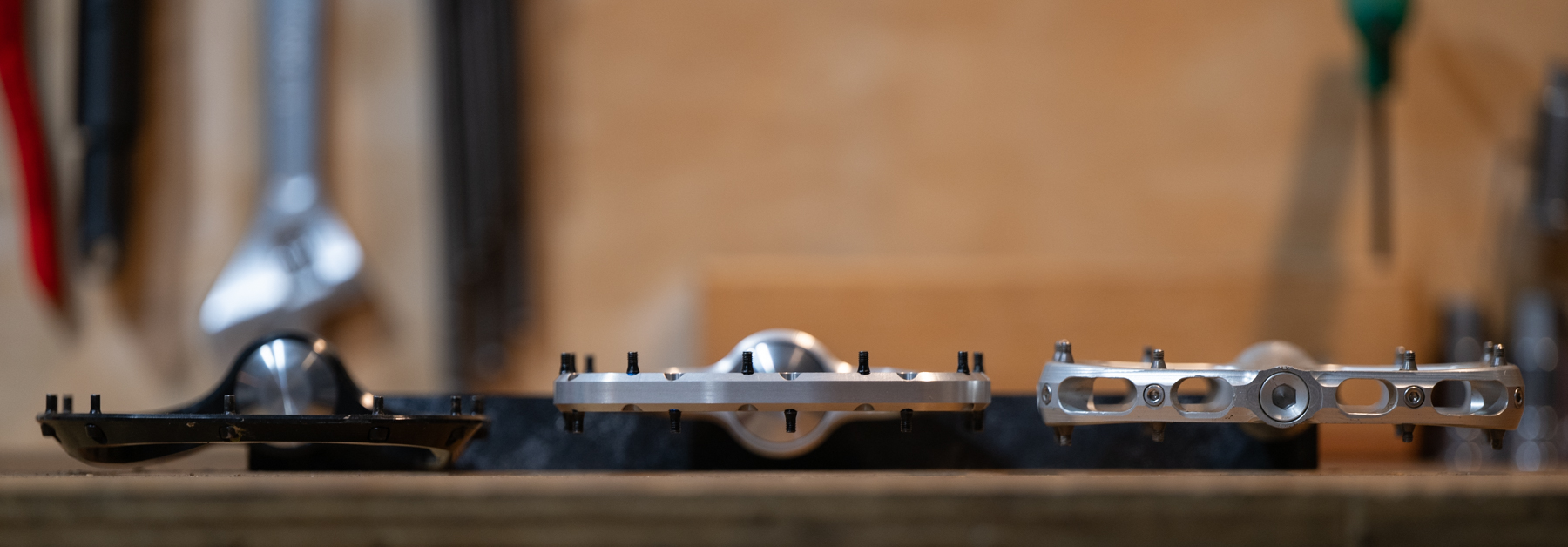
The bodies and spindles of both pedals are machined near Outlier’s headquarters in Calgary, Alberta, and Outlier offers a two-year warranty on both. There is a rider weight limit of 250 lb / 110 kg for both models, and Outlier recommends them for folks with US 7 men’s / 8.5 women’s / 40 EU sized feet and up. Outlier also says that the installation torque is more critical with their pedals than most, since installing the pedals on a crank arm also serves to preload the bearings; 30 Nm is the recommended spec.
With those general principles behind the design out of the way, let’s talk about how the two models differ:
Void
The giant opening in the middle of the Void pedal body is certainly eye-catching (and has attracted a lot of attention at the trailhead), but they’re actually the more conventional of Outlier’s two pedal designs. They’re symmetric and double-sided, with the pins slightly staggered to sit a little farther outboard on the leading edge and inboard on the trailing one, but there’s no fore-aft offset to the pedal bodies themselves. The platform is 115 mm long and 115 mm wide, measuring 100 mm from the end of the axle to the outer edge of the platform, and it’s 9.9 mm thick — thinner than the OneUp Aluminum Pedals at the spindle, and about the same as Canfield Crampons.
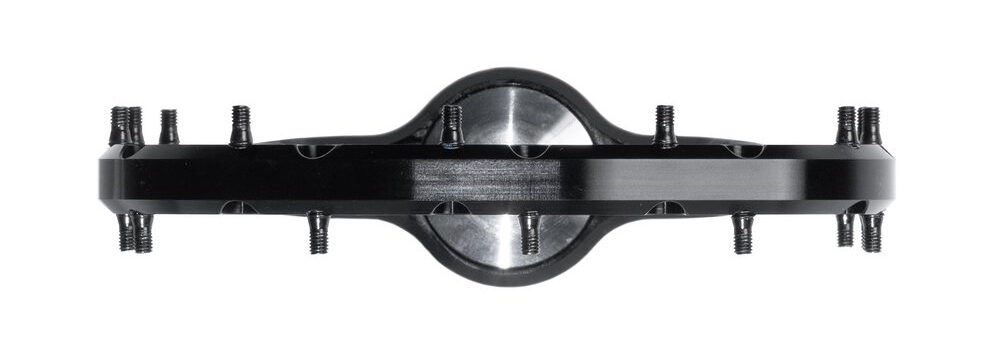
Pendulum
The Pendulum is where things get really wild. In contrast to the Void (and just about every other flat pedal out there), it’s a single-sided design, with the pedal body offset downward so that most of it — including the top face — sits well below the center of the spindle. The reverse side of the pedal body has no traction pins and no real flat surface to stand on.
The idea here is that by having the pedal body offset like that, you can make a pedal that feels really thin by putting the sole of the shoe below the centerline of the spindle (i.e., negative thickness, in a sense). That geometry also means that the pedal doesn’t need to be two-sided because it’ll self-right itself due to the offset pedal body and the effect of gravity.
That single-sided form factor also opens up a couple of other interesting possibilities. The underside of the Pendulum doesn’t have any protruding pins to catch on anything and is very heavily chamfered to help the pedal deflect off obstacles rather than hanging up. Its top-down profile is also asymmetric to better follow the contour of a foot — since the underside doesn’t need to match, Outlier can get weirder up top.
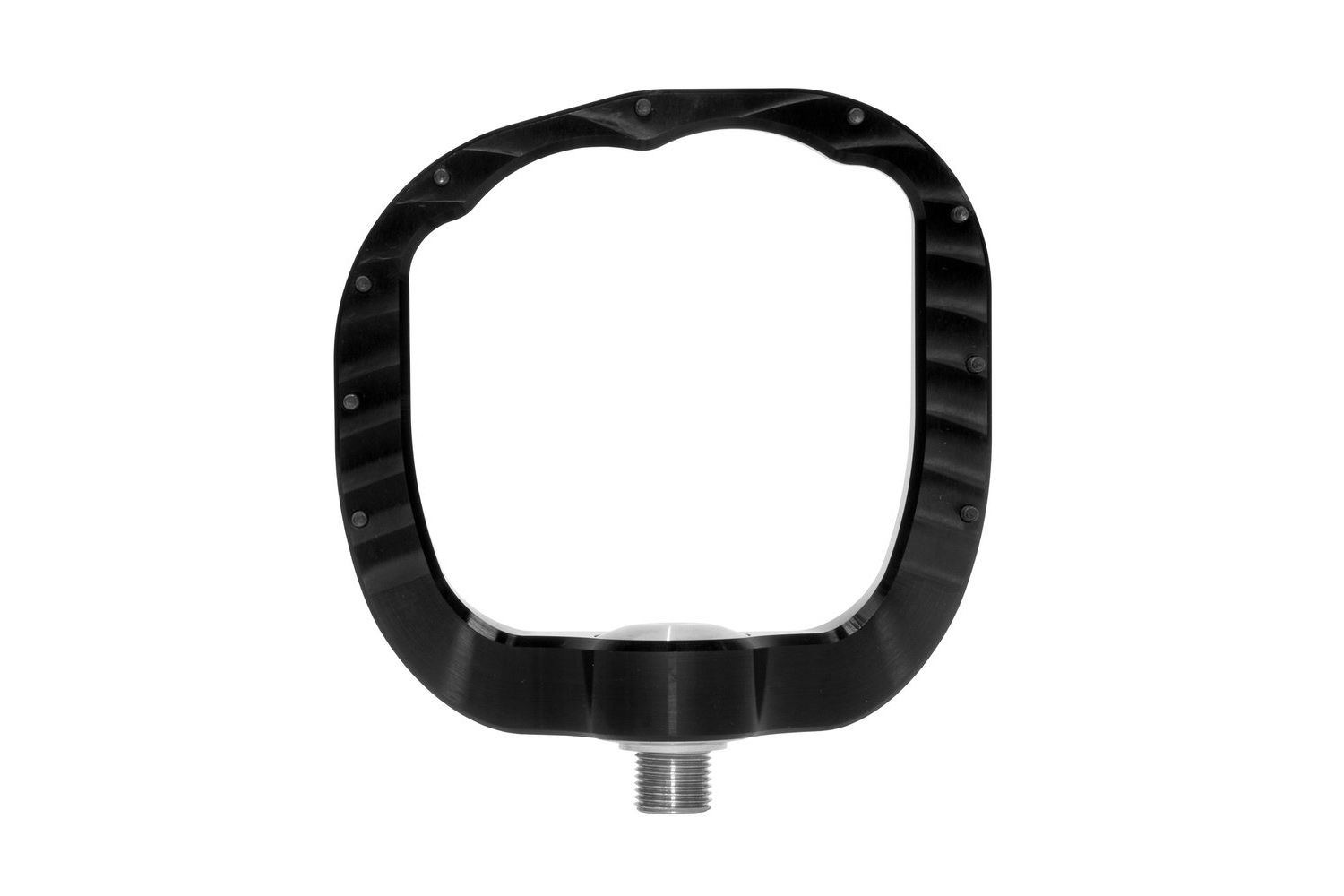
But it’s really the dropped platform design that caught my attention. I laid out the reasons I like thin pedals earlier, and the stable-feeling platform you get from them is at the top of the list. The Pendulum pedals put the top surface of the pedal body 6 mm below the center of the spindle — something like 14 to 18 mm below the top surface of most pedals, and about 11 mm lower than the Voids. That makes the Pendulum wildly thinner (or maybe we should just say “lower”?) than anything I’ve ridden before.
At least on a mountain bike, or in over 20 years. The idea of offsetting the pedal surface below the spindle isn’t a new one at all — Shimano gave it a whirl with their Dyna-Drive pedals way back in the late 1970s. Those were, of course, designed for road applications — mountain bikes didn’t really exist yet — and used dedicated cranks with much, much larger diameter pedal threads so that the bearings could be housed inside the crank arm. I actually owned a set briefly, on a Look La Vie Claire that I bought as a middle schooler who couldn’t afford anything more modern and still thought that racing road bikes sounded like a good idea.
Anyway, there have been some more recent attempts to make extra thin flat pedals by using a stubby axle with the bearings mounted inboard, including the Flypaper pedals from about 15 years ago (which used a custom FSA crank to house the bearings). Most variants have been truly flat across the top, though, and I’m not aware of any that offset the platform as the Pendulum does, so it’s easy to imagine that they could feel pretty different from anything else out there.
Outlier also made a couple of tweaks to the design of the Pendulum after the very early production runs:
- The latest Pendulum uses custom oil-filled angular contact bearings instead of open ones that relied on the pedal body alone for sealing.
- The newer Pendulum uses an updated pin design that’s meant to offer more grip.
- Outlier also added about 20 grams to the Pendulum body so that it self-rights more consistently.
By the time you’re reading this, any new Pendulums ordered from Outlier will be the new version. If you’re looking at a used pair, it might be worth bearing in mind, but the actual on-trail differences are pretty subtle. The updated bearings and pins can also be retrofitted to earlier Pendulums.
FULL REVIEW
Launching a new company with wild-looking new products is a tricky thing. Differentiating yourself from a sea of existing options has its obvious upsides, but a lot of folks are reluctant to try something too far afield of what they’re familiar with, especially from a new company without a proven track record.
Outlier founder, Cam Belisle-O’Donnell, has some good thoughts on that tension that he shares in Ep.271 of Bikes & Big Ideas (along with the backstory behind the Pendulum, the founding of the company, and a whole lot more). So, is Outlier onto something with the design of the Void and Pendulum, or have they just made some odd-looking curiosities? We’re ready to weigh in.
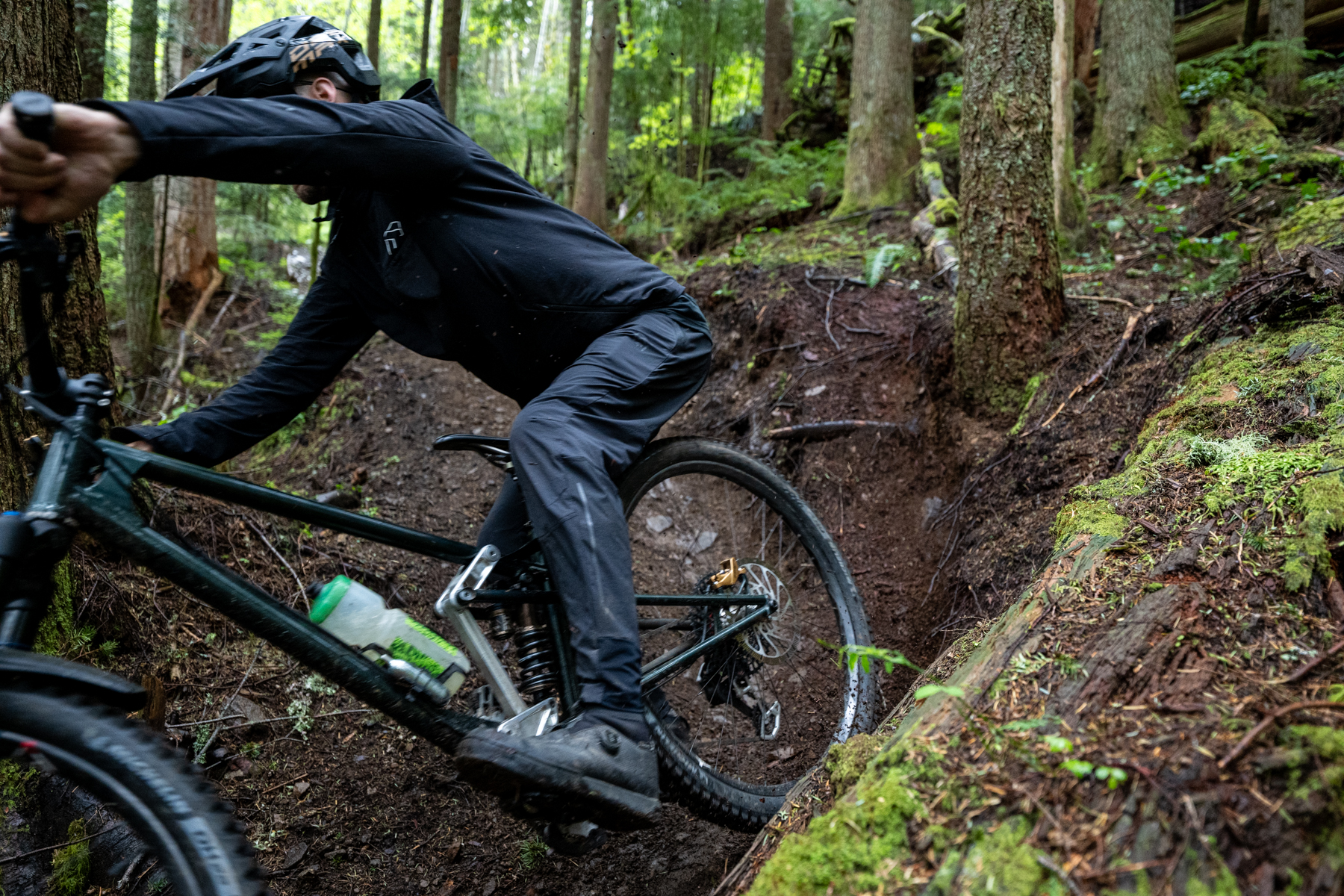
On-Trail Performance
David Golay (6’, 160 lb / 183 cm, 72.6 kg): We’ll start with the attributes that are common to both pedals, and then break out the ways that the Void and Pendulum differ.
It was the Pendulum that really drew my interest when I first saw it, so I started my testing there. My first impression after hopping on the Pendulums was that they feel a lot more normal than they look. We’ll tease out some ways that they feel different from the majority of other flat pedals shortly, but from the first pedal stroke, my take was much more “these are an interesting twist on a flat pedal” rather than “woah these feel weird.”
In particular, the huge hole through the middle of the pedal is way less noticeable than I might have guessed. Mostly, the Void and Pendulum feel like pedals with a lot of concavity, rather than feeling wholly unsupported in the middle. The outer edge of your foot is still supported by the pedal body; while the sole of the shoe (and with it, your foot) sags into the opening appreciably, it doesn’t feel super obvious that there’s such a large opening in the middle.
That said, shoe selection has a bigger impact on how they feel than it does with a lot of other flat pedals. I prefer relatively stiff-soled flat pedal shoes in general, but they feel more critical (at least for my preferences) on the Void and Pendulum than they do on most pedals that have a platform in the middle.
I’ve used a variety of shoes throughout my testing, with the Specialized 2FO DH (notably stiff) and Shimano GF800 GTX (less stiff than the 2FO DH but still above average) working best for me. More middle-of-the-road options like the Five Ten Freerider Pro and Trailcross GTX are fine, but start to give up a little more support than I’d like; really soft options like the Five Ten Sleuth DLX start to sag a lot and lead to my feet fatiguing relatively quickly on longer, rougher descents, though that’s true for me on more conventional flat pedals, too.
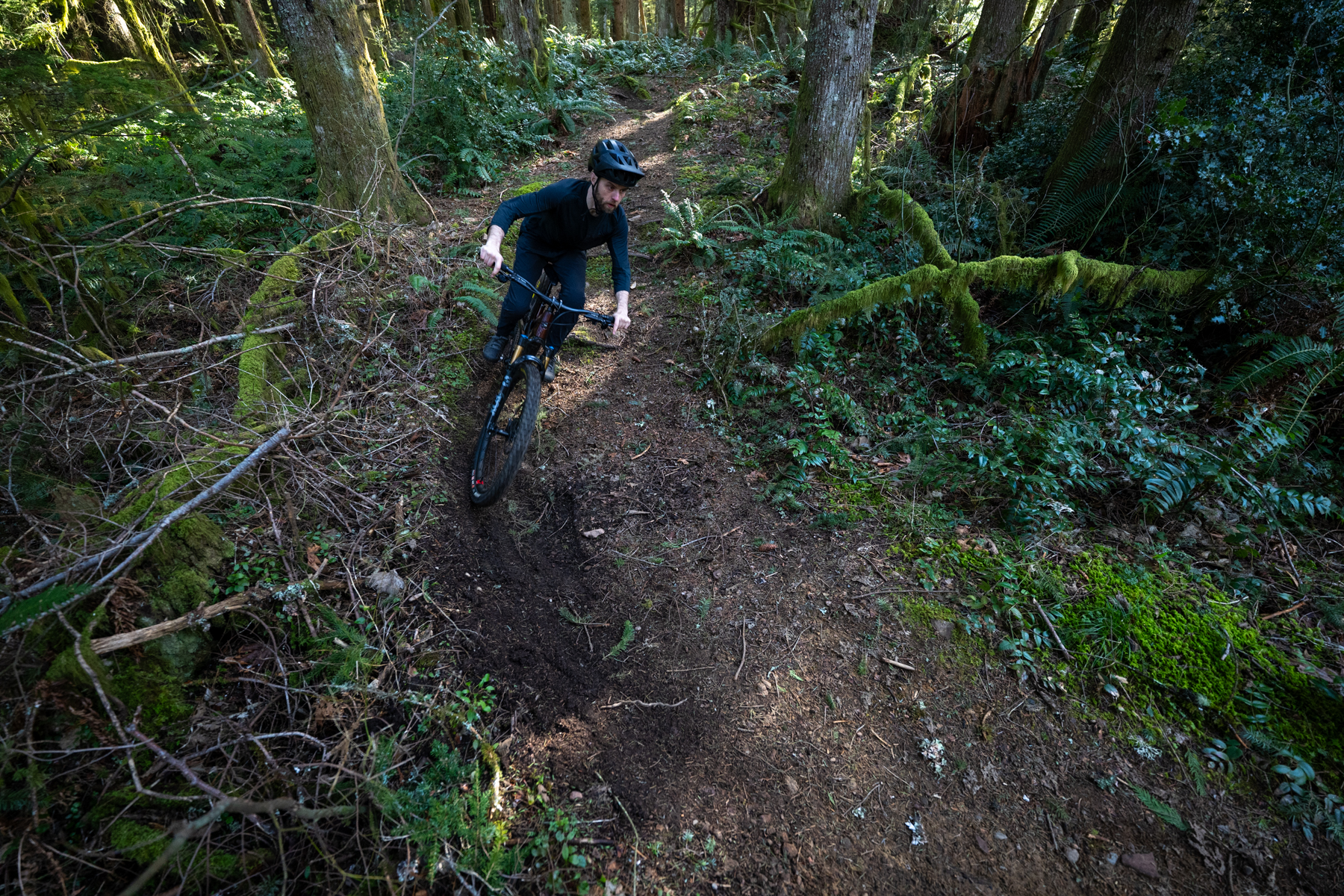
The bearing bulge on the Void and Pendulum is sizeable, but it hasn’t been a problem for me; how you feel about it probably depends quite a bit on your preferred foot positioning. I’ve got relatively average-sized feet for an adult man (US 10 / EU 43-44) and prefer to place my feet far enough forward on the pedals such that the ball of my foot lands forward of the bulge, and the bump nestles under / next to my arch, where it doesn’t push my foot outboard on the pedal much. If you prefer to place your feet farther back on the pedals, you’ll need to shift them outboard more to accommodate the bearing bulge.
I also suspect that folks with much smaller feet than mine will struggle more with support on the Void and Pendulum, both because spanning the gap between the leading and trailing edges will use up a larger percentage of the length of a small foot, and because a much narrower one might not reach the outer edge of the body as effectively. I don’t feel like I’m at the small end of the foot size range that will work, and I imagine people at least a couple of sizes down will be fine. For what it’s worth, Outlier recommends both pedals for folks with a minimum shoe size of US 7 Men’s / US 9.5 Women’s / EU 40 / UK 7; if I had to guess, I’d say that sounds about right.
Zack Henderson (6’, 160 lb / 183 cm, 72.6 kg): I went in the opposite direction of David in my testing of the Outlier pedals, starting with the Voids. And like David, I was initially worried about the weird shape, only to find it surprisingly normal-feeling underfoot. I didn’t really notice the missing middle of the pedal, and it went a long way toward simulating concavity by allowing my shoe to sink ever so slightly into the middle, um, void, in the pedal.
As David mentioned, both the Void and Pendulum consequently rely a lot more on the stiffness of the shoe sole, and while I found all of the shoes I tried (Fox Union BOA, Shimano GF800 GTX, and Ride Concepts Tallac) to feel fairly normal, the thinner sole of the Union BOA didn’t feel quite as well supported as the stiffer soles of the other two shoes.
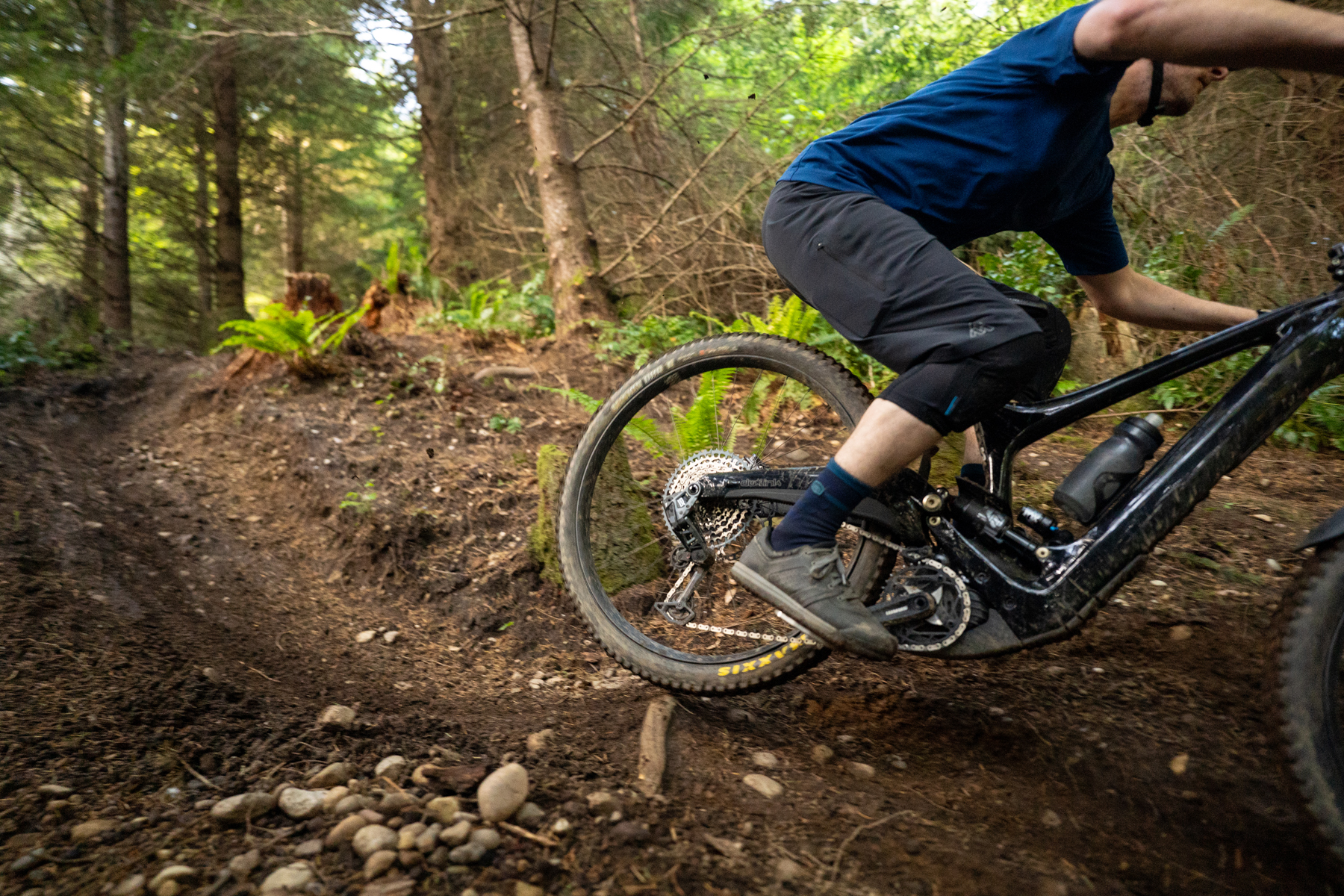
Unlike David, though, I did take some issue with how my foot interfered with the bearing housing. I evidently tend to run my feet a bit closer to the cranks than he does, and I found myself having to pay closer attention to foot placement on the Void and Pendulum than I did with other pedals that I typically use. I found that the bearing bulge tends to dictate a fairly specific foot position on the pedal, too — if I stomped onto the pedal with the ball of my foot a bit farther back, it would often land on the bearing bulge slightly and then be slid forward such that the bearing bulge aligned more with the narrower part of the shoe that tapers around my arch.
For whatever reason, I noticed this issue a little bit more often with Void, but it was present on both pedals. Folks who ride with their feet a bit forward on the pedal are less likely to have an issue, but if you’re someone who prefers to keep the ball of your foot closer to the angle, both Outlier designs may require some adaptation.
On-Trail Performance: Pendulum
David: As for the Pendulum itself, a few things stand out, both in comparison to the Void and most other flat pedals out there. The biggest one is that the dropped platform design really does have some upsides when it comes to foot stability on the pedal. The Pendulum is quite grippy in the traditional sense, but is a little less so than some of the most ultra-aggressive flat pedals out there (e.g., Chromag Dagga).
But despite not feeling like there’s quite as much grip from the pins / platform shape as, say, the Dagga, the Pendulum stands out for how easy it is to keep your foot positioned where you want it. As someone who switches back and forth between flats and clips quite a bit, I sometimes find myself getting sloppy with my technique on flat pedals while climbing, and rolling my foot forward off the pedal if I lift my heel too much as my rear foot is coming back up after a pedal stroke. Doing that on the Pendulum feels borderline impossible, and that sense of stability carries over to their descending feel, too.
The best way I can describe it is that the Pendulum offers more consistent grip and feel across a range of foot angles (i.e., how far your heel is dropped) than most other flat pedals. And by offering that stability / secure foot placement without needing to go wildly aggressive with the pins (they’re still substantial, granted), it’s also a bit easier to reposition your foot on the Pendulum than it is on some ultra-aggressive pedals, especially those with pins in the middle of the platform.
The smooth underside of the Pendulum is also a real asset when it comes to pedal strikes. Despite the downward offset, the bottom of the Pendulum doesn’t sit that much lower than a lot of other flat pedals since it’s so much thinner (especially once you take the pins on a traditional pedal into account), and the Pendulum is far, far less grabby when you hit it on something.
There are, of course, a few tradeoffs. I haven’t wound up putting my foot on the wrong side of the Pendulum often, but it has happened a few times (mostly when getting started from a standstill, rather than when quickly putting a foot out on the go). Getting the pedal flipped around the right way is pretty quick and easy if you lift your foot off momentarily, but it can still happen from time to time.
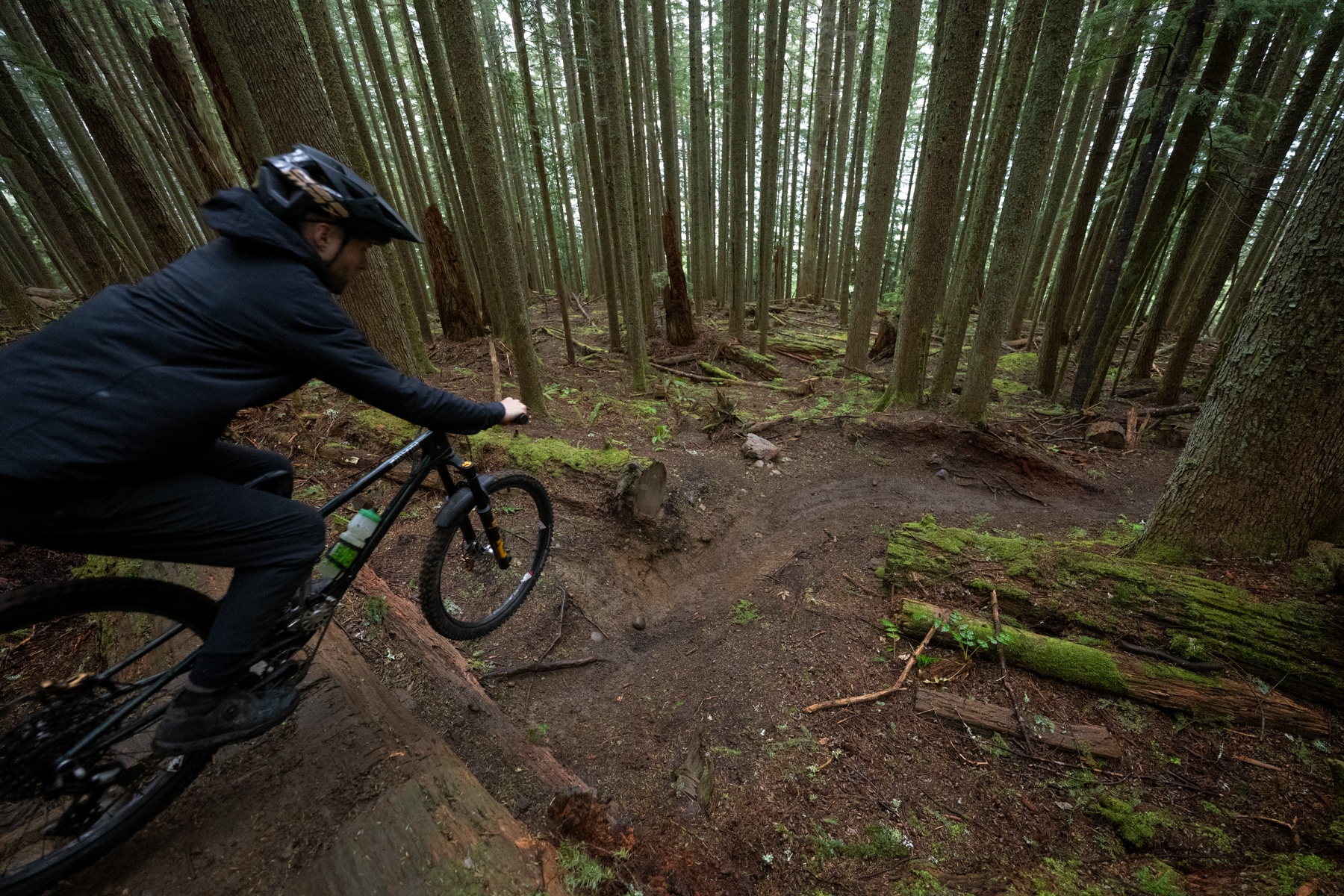
It also takes a touch more effort to bunny hop or pull into a manual with the Pendulum than it does on a pedal without the downward offset. It’s pretty subtle (and maybe just me), but something about the mechanics feels like it takes a slightly more exaggerated push into the pedals to start the motion.
The Pendulum’s offset is also significant enough to make a noticeable difference in how a given bike fits and feels. For starters, most folks will need to lower their seat a bit when switching to the Pendulum from a more conventional pedal. The offset is enough to make your seat feel higher; I also wanted to lower my bars slightly to compensate for the added effective stack height.
By dropping the top surface of the pedal so substantially, the Pendulum also makes a given bike’s bottom bracket feel lower, more from a handling perspective than a pedal clearance one (more on clearance in a minute). That effective lowering of the bottom bracket helps make a given bike feel a little more stable, a touch more planted, and helps make you feel a little more “in” the bike rather than riding higher on it. Whether that’s good, bad, or just different is going to depend a lot on the bike in question and your personal preferences.
My take is that I like those tweaks quite a bit on some bikes, and less so on others — it depends on everything else that’s going on, rather than there being a one-size-fits-all answer. But as someone who’s quite picky about cockpit setup and on-bike balance, the Pendulum feels like a bit of a double-edged sword; it’s another tool in the kit to make tweaks to how a bike feels, but also requires me to revisit my cockpit setup on a given bike. The more you’re planning to just commit to riding the Pendulum full time, the less that’s going to matter; if, like me, you like to swap between flats and clips with some regularity, it becomes trickier to manage.
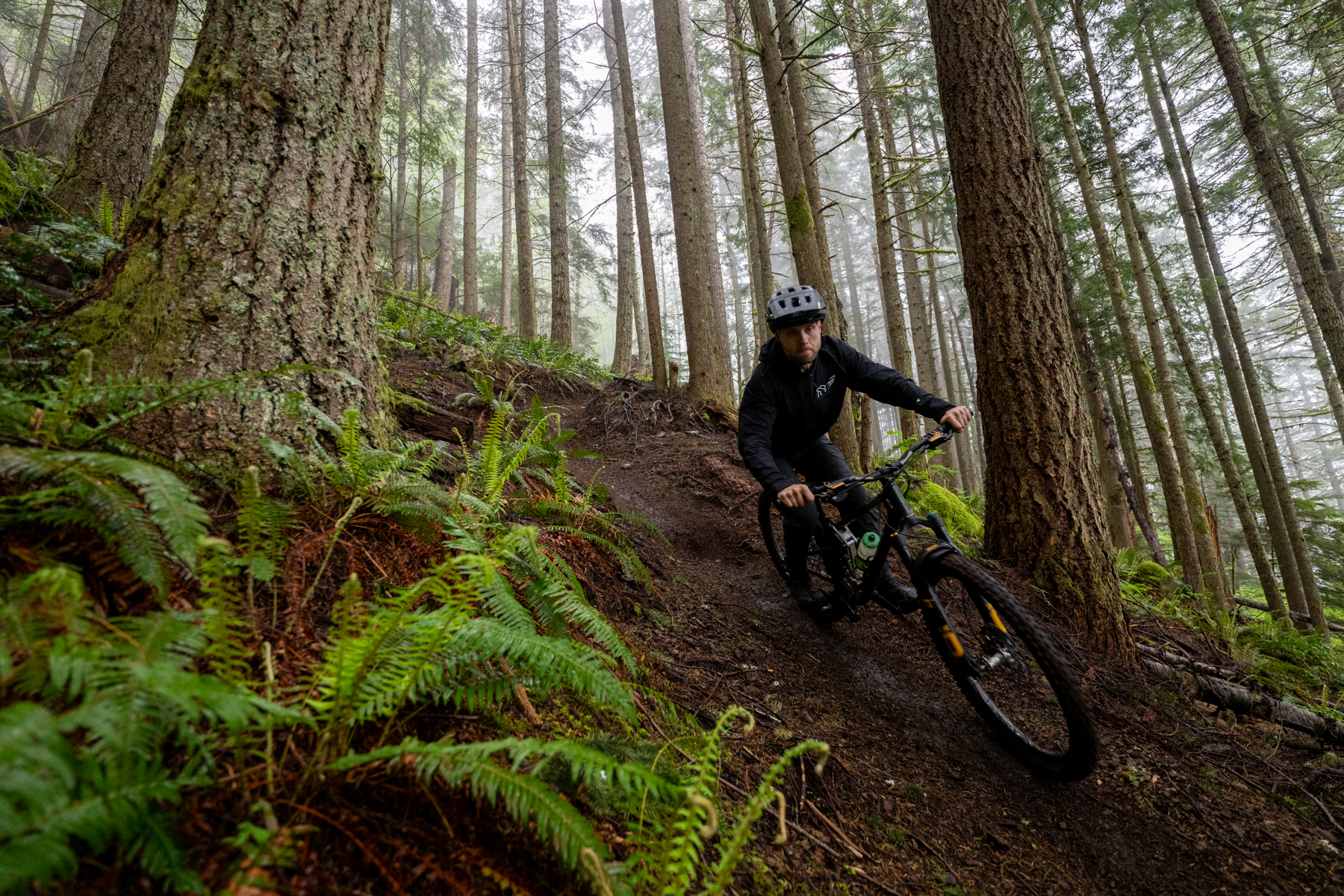
I haven’t felt any need to change my crank length with the Pendulum, but imagine that some folks might, if pedal clearance is a major concern. Again, the bottom of the Pendulum doesn’t sit all that much lower than the lower pins on a lot of conventional flat pedals (refer to the comparison photo in the “Design” section, above), but it does still rduce clearance slightly. More significantly, your foot sits substantially lower; if you’re prone to hitting your toes on stuff, going to shorter cranks would help.
Zack: I didn’t spend as much time with the Pendulums as David did, but I generally agree with his take on them. The Pendulums required me to lower my seat slightly, given their offset, and they also effectively increased the stack measurement by dropping my feet a bit lower than a traditional pedal. Shuffling a couple of headset spacers was all it took to get things feeling familiar again, but I was surprised by how much different the bike fit felt with the offset design of the Pendulums.
I generally agree with David that the Pendulums bring a perceived increase in stability, at the expense of some agility. I find bikes with taller bottom brackets to feel a bit easier to bunny hop and manual, and because the Pendulums shift your feet closer to the ground, I could feel a slight increase in the effort required to lift the front wheel.
As far as pedal feel and performance, the Pendulum was a mixed bag for me. On one hand, the offset design makes it feel virtually impossible to accidentally roll a pedal (i.e., for the pedal to roll forwards while riding and unsettle your foot’s purchase on the pins). Thicker conventional pedals are particularly guilty of pedal roll as a product of your foot being higher above the axle; by positioning your foot well below the axle, the Pendulum feels incredibly stable even when bashing through rough terrain. I was also impressed by the support and feel offered by the asymmetric platform shape.
I only had a couple of mishaps with placing my foot on the wrong side of the pedal, and always when starting from a standstill, like David mentioned. While that was a very infrequent occurrence, I sometimes struggled to get my foot in my desired spot on the pedal due to the Pendulum’s tendency to swing around a bit as it tries to self-center. Both when starting from a standstill and when trying to re-locate my foot while riding, I found that the Pendulum wanted to rock back and forth as I found my desired foot position, and I could end up with my foot perched in odd ways. Much of this is a product of the rather free-moving bearing and axle design, which is needed to allow the Pendulum to self-right.
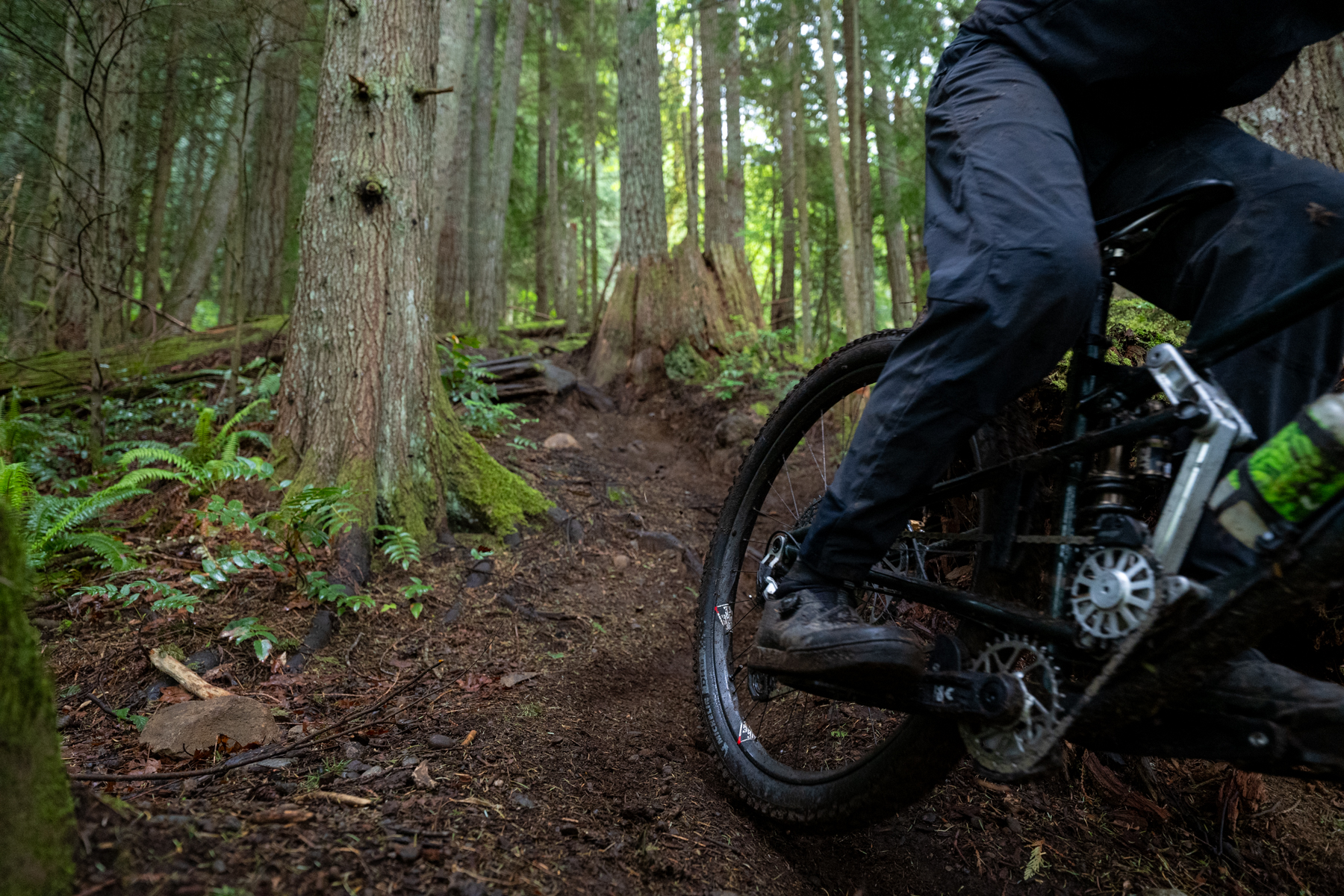
I didn’t find myself having any more pedal strikes than I typically do, but I did notice that I smashed my foot into things a bit more often than I do with conventional pedals. The heavy shaping of the platform and lack of pins on the bottom meant that the pedal easily skipped over things that it happened to run into, but the fact that my feet were closer to the ground meant that I was more likely to catch them on things at a given crank length.
David: As mentioned earlier, Outlier has made a few design tweaks to the Pendulum since the very early production runs. Having spent time on both versions, the performance differences are modest, but for the better. Improved bearing sealing is always welcome, especially in wetter climates; the new pins offer a little more grip than the old ones; and I really don’t care about 20 grams of weight on what are still relatively light flat pedals.
On-Trail Performance: Void
David: In short, the Void feels a whole lot like the Pendulum in many respects, and differs in a few details. Their on-pedal feel from the standpoint of how the shoe and pedal interface, and how your foot is supported, is very similar, as are their respective levels of grip. The Pendulum feels very slightly more supportive along the outer edge of the pedal, since its profile tapers to follow the shape of your foot (the Void can’t do so as readily since it needs to be symmetric), but that difference is subtle.
The Void is still appreciably thinner than most other flat pedals (especially those that also feel concave), and brings a touch of the added stability that I described feeling with the Pendulum, but that sensation is much more subtle with the Void. I still find myself adjusting my seat height fractionally when swapping between the Void and more conventional pedals, but the difference is far smaller than it is on the Pendulum, to the point that I don’t need to make any bar height adjustments or anything else.

All told, the Void just feels like a very nice, surprisingly normal flat pedal in most respects. It’s quite grippy, I like the concave feel, and they’re more straightforwardly plug-and-play than the Pendulum in terms of their impact on bike setup and feel. My preferred foot placement means that the bearing bulge is a non-issue for me, but folks who place their foot farther back on the pedal might notice it more.
Zack: David and I are largely in agreement here. The Void’s thin design is helpful given its otherwise large footprint, and it undoubtedly helped reduce the number of pedal strikes as compared to other pedals in my arsenal (Chromag Dagga and Race Face Turbine in particular). I didn’t necessarily feel the need to make seat height or bar height adjustments with the Void, though it did add the slightest bit of additional leg extension to my pedal stroke. The thinness of the design as compared to other traditional pedal shapes lends some additional stability, and I don’t think I ever once rolled a pedal while riding the Voids.
As I mentioned above, I did struggle a bit with the size of the bearing bulge, but that’s largely down to my preference of running my feet slightly farther back on the pedals than David does. I could likely adapt to the bearing bulge over time, but given that I’m so often swapping between different pedal designs, my foot’s interference with the bearing bulge tended to be a little jarring for the first couple of rides on the Voids after I hadn’t ridden them in a bit.
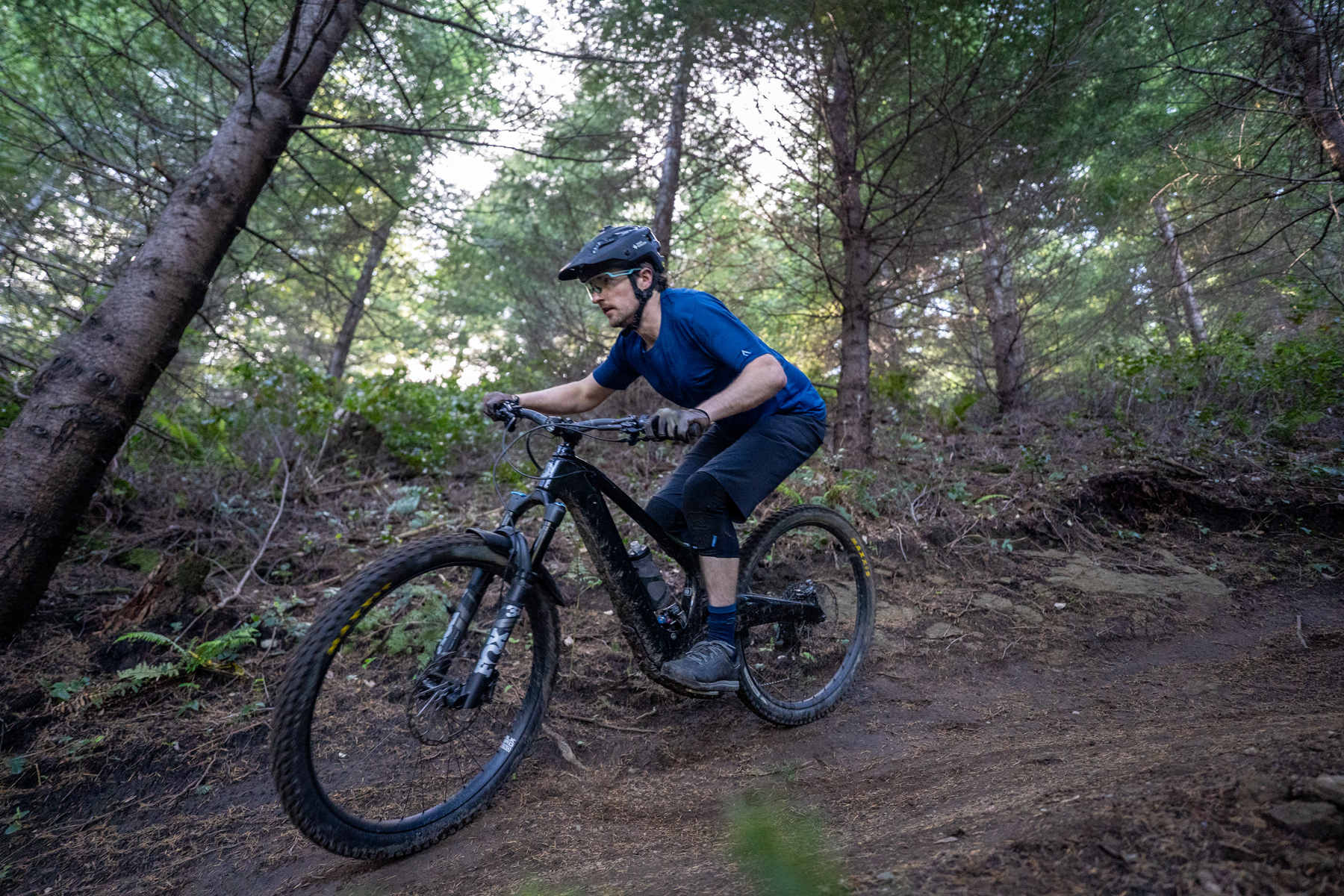
Another interesting issue that I ran into with the Void in particular was a squeak that occurred due to interference between the bearing cap and my shoe. The cap on the inside part of the pedal often contacts the shoe, but that cap also rotates throughout a pedal stroke. Something about the rubber on my Fox Union BOA shoes created a squeaking sound as the rubber contacted the cap, particularly whenever it was damp outside. Other shoes, like my Ride Concepts Tallacs, didn’t have the issue, but it’s worth noting.
Durability
David: I don’t have much to report. Both the Pendulum and Void are holding up well. The bearings are spinning freely, they’ve shrugged off a few hard pedal strikes without incident, and I haven’t broken or bent any pins. The tapered design that Outlier uses (the protruding part of the pin is a smaller diameter than the portion of the pin that’s threaded into the pedal body) should make for relatively easy removal of damaged pins if needed, and I haven’t experienced any creaking or anything else, despite the heavily cantilevered axle design.
The one thing I will note is that the axle design on both pedals preloads the bearings as the pedal is tightened onto the crank, so they’re more sensitive to installation torque than most pedals — especially the Pendulum, since keeping the bearings spinning as freely as possible is critical to it self-righting correctly. Outlier’s recommended torque spec of 30 Nm is not that high — with a long 8 mm Allen wrench, it’s very easy to overdo it — so keep that in mind. If you’re having trouble with your Pendulums not self-righting correctly, it’s the first thing I’d check.
Zack: I’ve been impressed by how solid both the Void and Pendulum have been, especially after seeing a hefty amount of shared use by both David and me. The pedal bodies feel particularly resilient compared to some other pedals, given that both the leading and trailing edges are a single solid unit without any cutouts or delicate shaping. I had a couple of very hard impacts with rocks during testing, and the pedals escaped entirely unscathed aside from a small scuff or two.
Who’s It For?
David: I think there’s a lot of overlap in the appeal of the Void and Pendulum, and the decision between the two should come down to how (or whether) you want to tweak the fit and feel of the bike in question.
Both pedals are going to work best for folks who want a very thin-feeling pedal that’s effectively concave, and prefer to run their feet far enough forward and/or outboard on the pedals that the bearing bulge won’t be in the way. I also don’t think that you need particularly big feet to get along with either — my US 10 ones are more than enough — but folks with small feet might find the opening in the middle of the pedals to be too large.
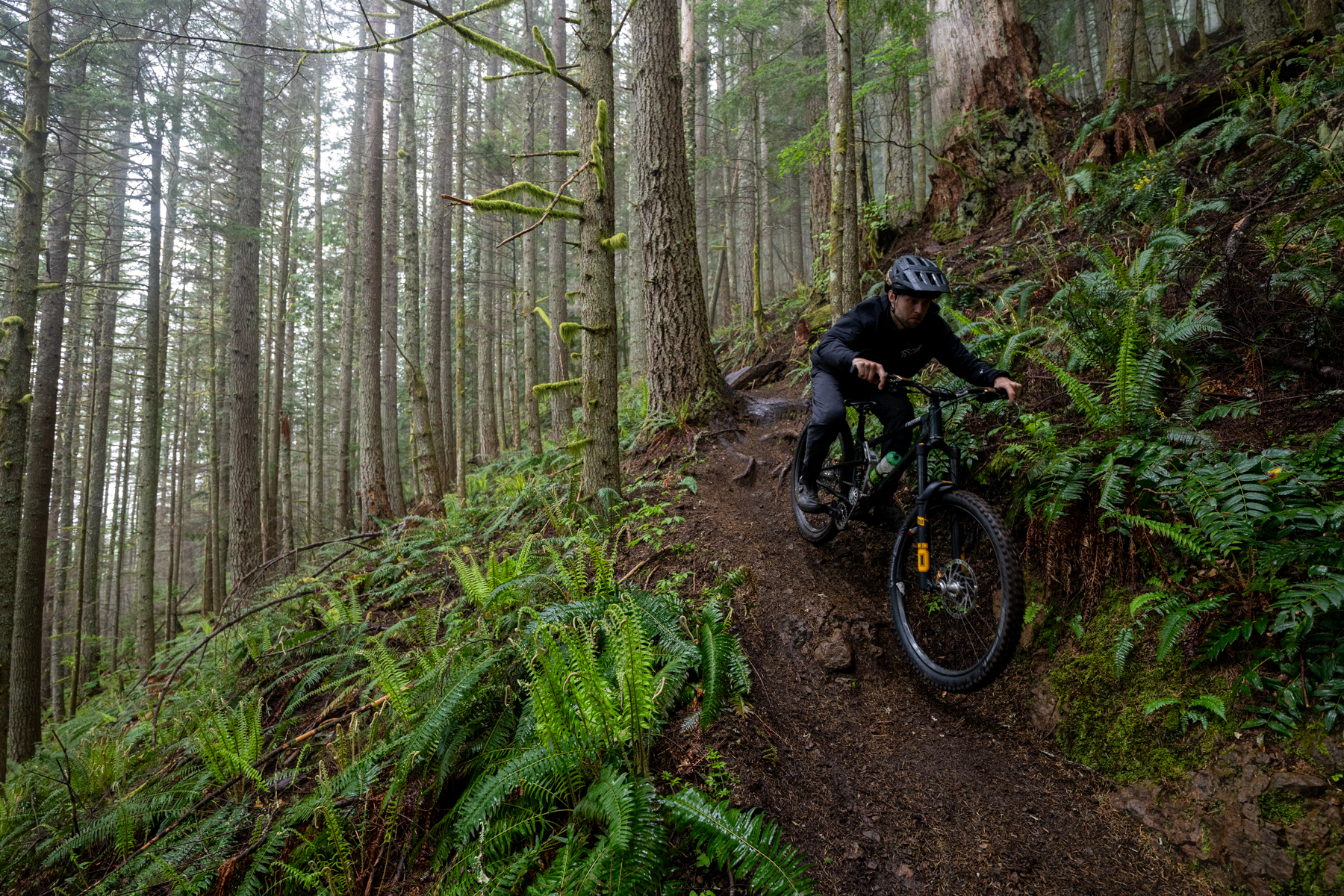
Those caveats aside, both versions offer relatively high levels of grip and excellent foot stability on the pedal, while feeling genuinely concave (despite the platform shape technically being flat across the top). The biggest thing that sets them apart is that the offset of the Pendulum makes them feel even more stable than the Void, while also making a given bike feel like its bottom bracket is noticeably lower, and effectively increasing the stack height.
Whether those changes are good, bad, or neutral depends on your preferences for the bike in question, and to some extent, how picky you are about cockpit setup. I’m happy swapping back and forth between the Void and other more conventional pedals (clip or flat), but the Pendulum requires enough setup tweaks that going back and forth is more of a chore. If you’re going to stick with the Pendulum full time and/or aren’t as fussy about cockpit setup as I am, it won’t matter so much, though I think most folks will need to lower their seat ~10 mm at a minimum.
Zack: I’m with David on the notion that both the Void and Pendulum feel a lot more normal than expected. Aside from my small foot placement gripes relating to the large inboard bearing bulge, I’d just underline David’s point on the Pendulum feeling different enough that it requires some adaptation in bike setup. It’s important to anticipate those effects, mostly just because the Pendulums are so unique when compared to any other pedals I’ve tried in how much they impact handling traits.
Bottom Line
David: Outlier has come up with two genuinely novel takes on a flat pedal design, and while they won’t be for everyone (what product is?), both the Void and Pendulum offer some notable upsides compared to more conventional flat pedal designs, and feel a lot more normal than their out-there looks might suggest. Both offer excellent grip and foot stability on the pedal and have held up great, putting our initial concerns about the cantilevered axle design to rest.
Both pedals have a few quirks, but they’re understandable design tradeoffs to achieve the goals of making especially thin, concave-feeling pedals, and both the Void and Pendulum deliver on that front. For folks whose preferences align with what the Void and/or Pendulum do best, we haven’t found anything else like them.

So looking forward to the full review and getting an order in. The inventors comments in the podcast certainly raise some doubts for “enduro track” use.
Size 45 (US11) shoes.
Have had them out on about 2 dozen rides now, including some racing.
Grip is awesome. Stability is awesome.
I do occasionally step onto the bottom of the pedal, especially when I start riding. Surprisingly, due to the cut out, grip is not too bad there.
I have not had issues with pedal strikes. The very few strikes I had, it slipped off nice and smooth (no pins on the bottom!).
The one issue I have, is hitting the top of my toes. (Obviously while pedaling). I did this very occasionally on my previous pedals too, but more on these.
I think it’s because my foot is a couple of mm lower, and because of the pendulum mechanism, my foot goes even more toe down at the back/bottom of the pedal stroke (just like it naturally goes more heels down when the crank is forward, or when you hit bumps).
So based on this, I would recommend that people pair the Pendulums with shorter cranks if they already had issues with pedal/toe strikes.
David, you mentioned that foot size may impact the performance of this pedal for certain riders, but what about foot width? I have a fairly wide foot at 110 MM wide and wear a size 9.5. Also does the Specialized 2FO DH and Shimano GF800 GTX shoes that you mentioned above work well for wide feet? I remember you mentioned you have wide feet?